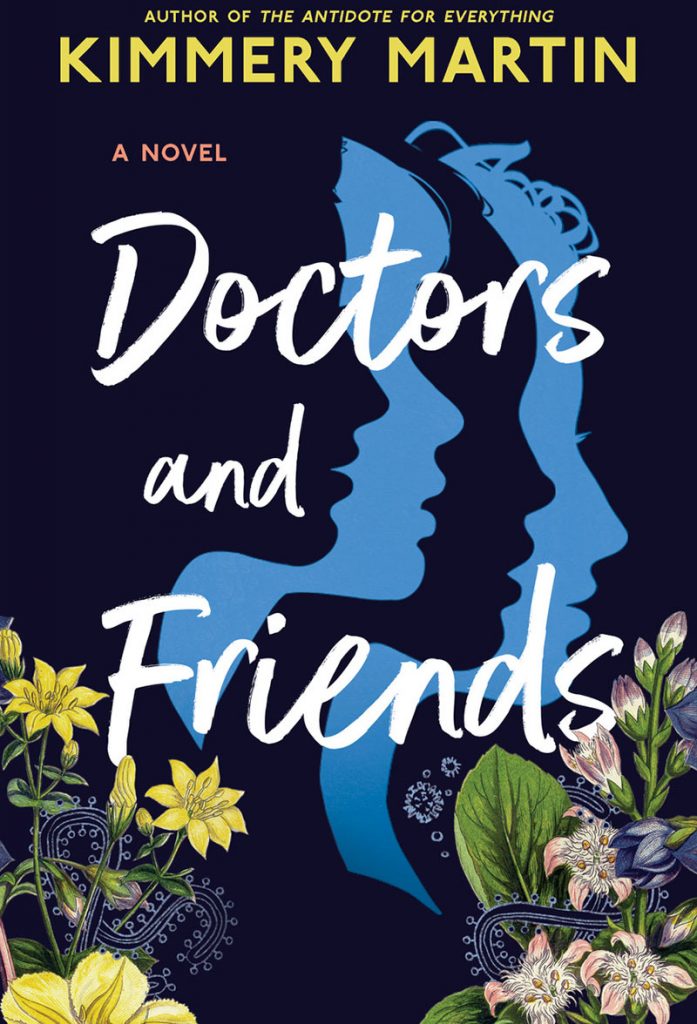Q&A: Kimmery Martin
November 4, 2021

In her new book, the Charlotte ER doctor-turned-novelist tells the story of the pandemic that could have been.
by Cathy Martin
Kimmery Martin’s third book, Doctors and Friends, was written prior to Covid-19, but don’t expect much similarity between our own pandemic experience and the imaginary outbreak that takes place in the book.
Doctors and Friends, which debuts Nov. 9, tells the story of three friends from medical school who find themselves, while living in separate cities, facing an outbreak of a fast-spreading virus. Though the subject is a bit weightier than in Martin’s previous books (The Queen of Hearts, her debut novel published in 2019, and The Antidote for Everything, published in 2021), it’s less of a cautionary tale than it is a story about the sustaining power of friendship during unusually challenging times.
Ahead of the book launch, SouthPark spoke with Martin about the new book, her writing process and what she’s been reading lately.
Comments were edited for length.

How did you come up with the idea of writing about a pandemic before we actually experienced one?
I first wrote an essay in 2018 about a book I wanted to write. I had the idea that the main character would be a woman whose personality was somewhat like my father’s personality — he was my person and he died unexpectedly, and he had a very singular and unique personality. And if he were a doctor, I think my dad would have been an infectious disease doctor. So I wrote to my editor, and I said, “What do you think about a novel about an infectious disease doctor in the middle of a new pandemic?” I didn’t really start it until 2019, when I did the bulk of the research and the drafting and outlining.
I didn’t foresee Covid at all. I did think that we would have a pandemic at some point. I just didn’t think it would happen a few months later. It was really inspired by some of the nonfiction books that I had read, especially The Great Influenza and a book called Crisis in the Red Zone. I sort of put those two books together and came up with a fictional virus.
The title, Doctors and Friends, reflects common themes across all of your books. What’s different about this one?
All of my books have explored the concept of friendship as a fundamental human relationship. The characters have romances and they have work relationships and they have children, but the friendships in the books are the most important relationships.
They’re all centered around a group of the same friends. In my real life, I have a group — there are seven of us who graduated medical school together — and these women have been my closest friends for over a decade. So they were pretty much a loose inspiration for the story.
But this book differs a little bit in tone from the other two. It’s a more intense subject, certainly. I do tend to have a lot of humor in my writing, and there is some in Doctors and Friends. But obviously it’s a little bit more of a wrenching subject matter than the other two. I tried to balance that by bringing hope, and sweetness and optimism and some lighthearted stuff when I could.
It’s also a bit more of a sweeping novel — it takes place on multiple continents and in different cities.
How does the writing process start for you?
I usually start with the protagonist. I think about who’s going to be the main character and what she’s like, what her personality and background and attributes are, and what her voice is like.
I need at least the germ of an idea of the plot. I usually start with a one-sentence encapsulation of the main hook of the story that’s going to involve this protagonist. But it is pretty character-driven.
My three novels so far have been spinoffs, so in each book one of the minor characters from the previous book becomes the main character of the next book. They all take place in the same fictional universe, but they’re not a series.
During Covid, did you feel drawn back toward practicing medicine?
I really felt guilty that my friends and colleagues were suffering — and they were suffering, especially in the beginning before we had effective good treatments and when a lot of the clinical characteristics of the virus were new to everyone. It was wrenching for these doctors and nurses and everyone in the medical setting to see so many people die and not be able to stop it. And the hours were insane, there was so much struggle there. I really wanted to be helping them.
I wound up volunteering at vaccine clinics once those opened and I kept my name registered with the state of North Carolina to be on an emergency medical list, so if the hospitals were going to overflow and go to tents, I was signed up to work in those tents if they came to be. I really miss the ability to help people in that very visceral, immediate way that you do when you are an ER doctor.
What do you say to people who might think, ‘We’ve just lived through a pandemic, I’m not sure I want to read about another one.’ Why should they read this book?
That’s going to happen. I already know there are people who liked my other books who won’t pick this one up because they still feel traumatized or have too much fatigue.
I would say first, I did try to make this a hopeful, optimistic book. The nice thing about fiction is that the author controls the ending. This is kind of the pandemic that could have been.
In the original draft of the book, the way I portrayed the societal and governmental response to a catastrophic outbreak of illness was very different from what wound up happening in real life. I wrote the book originally as a cautionary tale, which we don’t need. So now I think it’s interesting to see how somebody imagined it happening right before it happened, and what was accurate and what was really different.
And I think, as a writer and as a reader, it will give people some degree of control over things that in real life that we couldn’t control. It gave me a sense of control, and the reader will at least benefit from knowing there’s a relatively happy ending.
What else should people know about the book?
Mainly, I would emphasize to people that this book does not reflect Covid. It isn’t going to reflect the experience that you had during Covid. It isn’t going to be an accurate depiction of what we went through. There are things in it that actually did turn out to be very accurate. Then I revised it and edited it after Covid, and I added things like Zoom scenes to make it a little more realistic. … But it truly is an imaginary pandemic.
I think the most heartening message of the book is that these women love each other, and they have a solid friendship that has endured for a long time. And during what turns out to be a horrible struggle for everyone, they are able to draw on the strength of this friendship which sustains them. And that, I think, is a comforting thing during a real-life pandemic.
What’s on your bedside table?
I just started a book that I am loving called My Year Abroad by Chang-rae Lee. It’s very literary, so it’s a slow read – it’s one of those books you can just dabble in at different times and then come back to, but I love his voice, it’s really entertaining and unique. SP


